|
|

 |
O moral Gower, this book I directe
To the and to the, philosophical Strode,
To vouchen sauf, ther nede is, to correcte,
Of youre benignites and zeles goode. |
Troilus and Criseyde (Book 5, l. 1856-1859)
Richard II was a great patron of the arts and a literary culture flourished
at his court in the second half of the Fourteenth Century. Chaucer was widely
known amongst the literati of the day, and his circle included influential
figures such as Sir Lewis Clifford, Sir Richard Stury and Sir John Montagu. He
was also friendly with other contemporary writers, including Thomas Hoccleve,
Henry Scogan, Ralph Strode and John Gower. He seems to have been particularly
close to ‘Moral’ Gower, as he dubs him in Troilus and Criseyde, giving him power
of attorney when he left for Italy in 1378. In the first version of his
Confessio Amantis, Gower makes a flattering reference to Chaucer as composing
‘ditees and songes glad’ in the flower of his youth.
Often referred to as the ‘Father of the English Language’ Chaucer’s poetry
and use of English inspired a whole generation of poets. The dominance of French
following the Norman conquest of 1066 had impeded the growth of English as a
literary language for hundreds of years, and it was not until the Fourteenth
Century that the vernacular came once more to be used as the language of choice
in all areas of society, including at court and in business. Nonetheless, most
writers – such as Gower – still wrote fluently in French and Latin, as well as
in their native tongue. Chaucer proved that English could be written with
elegance and power and it is thanks to his works that its prestige grew as a
medium for serious literature. His poetry naturally inspired praise and
imitation from his contemporaries. Of these admirers, the prolific John Lydgate
is probably one of the best known today. A monk at the great Benedictine Abbey
of St Edmund at Bury, he emulated Chaucer’s style, and in the prologue to his
Siege of Thebes even portrayed himself as meeting Chaucer’s pilgrims at their
inn in Canterbury. Although Lydgate’s work has suffered from adverse criticism
(the antiquarian Joseph Ritson famously dismissing him as a ‘voluminous,
prosaick, and drivelling monk’) he played a crucial role in ensuring Chaucer’s
popularity throughout the Fifteenth Century.
|
|
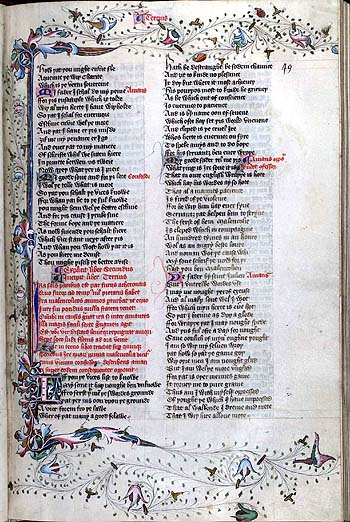
Illuminated page beginning Book 3 (folio 49r) |
John Gower Confessio Amantis
England: c.1425-1450
MS Hunter 7 (S.1.7)The Confessio Amantis is Gower's most acclaimed English work. Completed in
its first version in 1390, when Gower was about sixty, it is a lover's account
of his confession to Genius, the priest of Venus, under headings supplied by the
seven deadly sins. Like The Canterbury Tales, Gower uses this narrative
framework to tell a series of tales which in this work explore the general
nature of each sin together with the particular forms it may take in a lover.
Chaucer undoubtedly knew the work well. According to the original prologue,
Gower wrote the book for Richard II after the king asked him for a poem on the
theme of love. Two or three years later, the reference to Richard was cut out,
presumably because of his growing unpopularity. Gower then wrote another version
of the prologue in which he says that the work was written for ‘Engelondes
sake’.
The decorative scheme in this manuscript was for the beginning of each book
to be marked by an illuminated and decorated page. The opening of the third book
is displayed to the left; it is adorned by a spraywork border incorporating floral and
leaf motifs. Several of these pages (including the beginnings of books one, two,
six, seven and eight) are missing, and this may suggest that they originally
included miniatures as well. There is a seventeenth century inscription in the
book indicating that it was owned by the Benedictine Abbey of Bury St Edmonds:
if this is correct, then this copy is likely to have been read by John Lydgate.
|
|
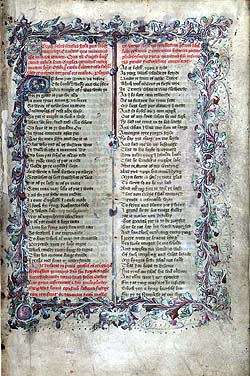
Illuminated page beginning text (folio 1r) |
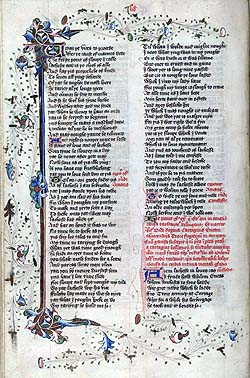
Illuminated page beginning book 4 (folio 65v) |
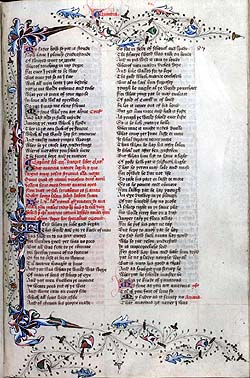
Illuminated page, ending Book 4 and beginning Book 5 (folio 87r) |
|
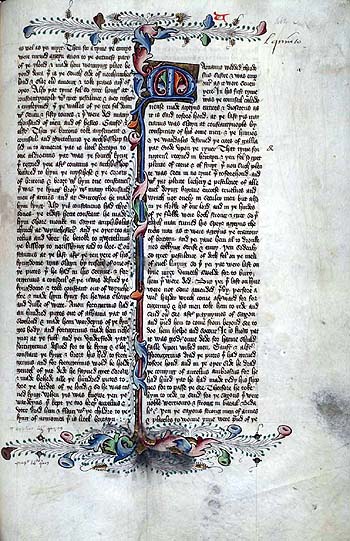
Illuminated page beginning Book 5 (folio 113r) |
Ranulf Higden Polychronicon (translated by John of Trevisa)
England: c.1470
MS Hunter 367 (V.1.4)Originally composed in Latin, this universal history is a chronicle of the
period from the Creation to 1357. Its author was a Benedictine monk who arranged
the work into seven books, in imitation of the seven days of Genesis. This
translation was made by John of Trevisa (c.1330-1412) and completed in 1387.
There was an increasing interest in history throughout the late medieval period,
and Trevisa’s version was just one of several standard vernacular histories
available. His translation is interesting for the additional comments that he
makes to update the original text. Where Higden, for example, discusses the fact
that children learn their lessons in French, Trevisa comments that the
situation has changed by the time he is writing, and that lessons are now
conducted in English. He acknowledges that this has its advantages for speed of
learning, but points out rather disapprovingly that now children ‘know no more
French than their left heel, and that is harmful for them if they should pass
the sea and work in strange lands’.
This copy is one of some fourteen surviving manuscripts of the translation.
It also includes Higden's preface to the work, the Dialogue of the Lord and
the Clerk. The manuscript is well written on vellum and is skilfully decorated
with illuminated initials and floreated pages. To the left is the opening of the first
chapter of Book Five which deals with the reign of Vortigern in Britain and the
arrival of the Saxons Hengist and Horsa.
|
|

Illuminated page beginning text (folio 1r) |
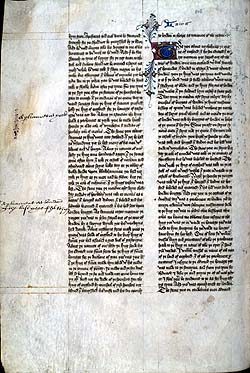
Page with floreated initial 'T' (folio 200v) |
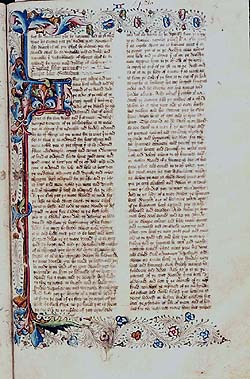
Illuminated page beginning book 2 (folio 34r) |
|
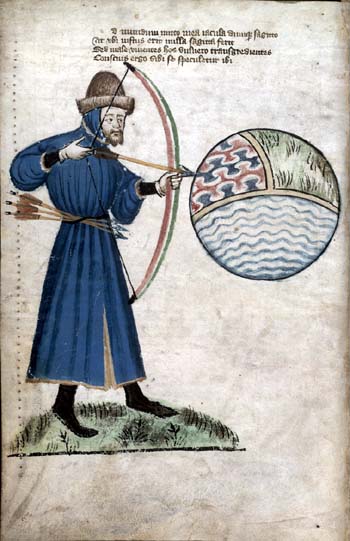
Portrait of Gower (folio 6v) |
John Gower Vox Clamantis
England: c.1400
MS Hunter 59 (T.2.17)Gower used the Peasants’ Revolt of 1381 in this long Latin poem to describe
the faults of government and the various classes of society. Caused by a complex
interaction of social discontents, the Revolt was a brief but horrific episode
of anarchic insurrection. The rebels (not all of them peasants) plundered
London, massacred a group of Flemings, and murdered the Archbishop of
Canterbury. The earlier portion of the Vox Clamantis contains a vivid account of
this uprising in the form of an allegory, with a somewhat hysterical portrayal
of the rebels as domestic animals reverting to bestiality. Chaucer himself only
makes one passing reference to the Revolt in a facetious remark about Jack
Straw, one of its main leaders, in the Nun’s Priest’s Tale. Nonetheless, as a
member of the upper class, he probably shared Gower’s view of the rebels as
being a lawless rabble.
In this copy of the revised version of the Vox Clamantis and Chronica
Tripertita, the text is preceded by a full page representation of the author
firing his shafts at the world. This globe is composed of the elements of air,
earth and water in three compartments. There is a second illustration (found
towards the end of the text) of the Gower arms supported by two flying angels,
with a cloth-covered bier below. This does not depict Gower's coffin, as the manuscript was actually made before
his death in 1408. In fact, the text has been revised and corrected by means of
extensive erasure and substitution, possibly under the supervision of Gower
himself. There seems originally to have been another illustration on folio 131v,
but this has also been erased and only survives as a shadowy palimpsest beneath
the text.
|
|
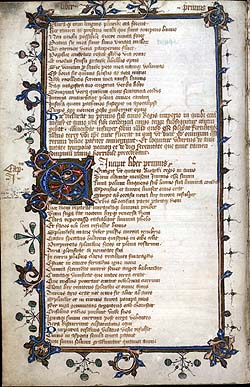
Decorated page beginning book 1 (folio 7v) |
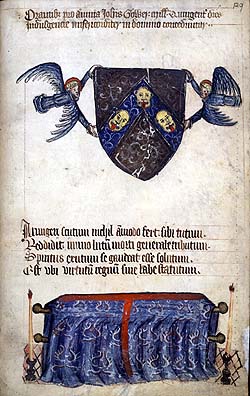
Shield with Gower arms (folio 129r) |
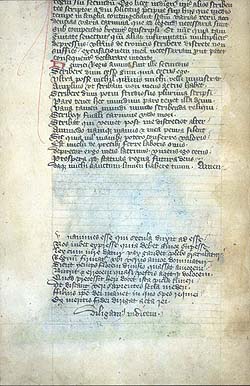
Folio with palimpsest of illustration (folio 131v) |
|
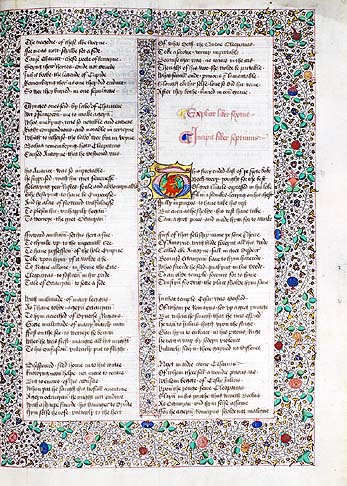
Illuminated page beginning Book 7 (folio 161r) |
John Lydgate Fall of Princes
England: c.1470-1480
MS Hunter 5 (S.1.5)Lydgate is credited with some 145,000 lines of verse, almost a quarter of
which is contained in the Fall of Princes, his longest single work. The poem is
a greatly amplified version of Laurent de Premierfait's translation of
Boccaccio's De Casibus Virorum Illustrium, with additions from a variety of
sources including the Bible, Ovid and other works by Boccaccio. The result is a
universal encyclopaedia of history and mythology, somewhat ponderous in tone and
exhaustively fleshed out with moral teaching. The work was commissioned from
Lydgate in 1431 by Humphrey, Duke of Gloucester, younger brother of Henry V and
Protector of England during the minority of Henry VI, and it occupied the
following eight years of his life.
This is an imposing de-luxe copy of the work, written out in a very neat
hand. Its major decoration is found in six full page borders, filled with
delicate sprays of penwork in a foreign style. Like our copy of Gower's
Confessio Amantis, this copy is incomplete, the pages at the beginning of books
three and four having been cut out, probably for their decoration. One of the
quires has also been misbound, and several notes in an early seventeenth century
hand (including the instruction on one folio to 'Turne forwards eight leaves')
attempt to make this explicit to any reader. Another interesting feature is a
number of crossed out lines on folio 197r obliterating references to the female
'Pope Joan'. There are
several early ownership inscriptions at the end of the volume, including records
of the births of some members of the Lumner and Calthorpe families in the
Sixteenth Century.
|
|
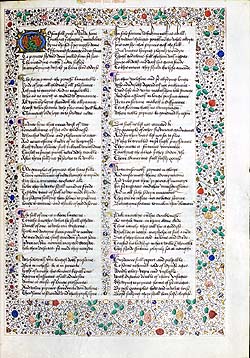
Illuminated page beginning book 2 (folio 41r) |
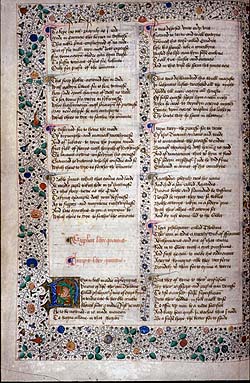
Illuminated page ending book 4 and beginning book 5 (folio 125v) |
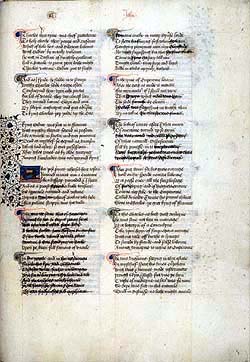
Illuminated page with crossing out (folio 197r) |
|

Opening with annotations (folios 99v-100r) |
John Lydgate Life of Our Lady
England: c.1450-1500
MS Hunter 232 (U.3.5)Lydgate wrote religious poetry throughout his career. The quasi-liturgical
Life of Our Lady was probably composed for Henry V in about 1415-16. A genuinely
devout composition written in the ‘high style’, the work draws upon the
Apocryphal Gospel of Pseudo-Matthew, as well as other devotional texts such as
the Meditationes Vitae Christi. It has been praised for its religious intensity
and luminous rhetoric.
The manuscript is incomplete, missing the final part of the poem. It is a
fairly standard fifteenth-century production, well written with penwork initials
throughout, but lacking any illumination. It is interesting for its copious
early sixteenth-century marginalia. As well as numerous signatures, doodles and
pen trials, it bears fragments of administrative type annotations relating to
indentures, scraps of doggerel verse, and lines of quotations from the Gospels.
The opening on the left is typical: in the lower margin of the left hand page, the
beginning of the verse at the top of the page is repeated, while if the book is
turned upside down, a fragment of a poem may be read (‘Mussynge in my mynde
grete / mervell that I heve that ever / so fayer a mayde shoulde heve …’), along
with some practise letter ‘h’s and what might be a monogram. Many of the names
found in the margins are connected to the Goldings, an important Essex family of
the Tudor period.
|
|
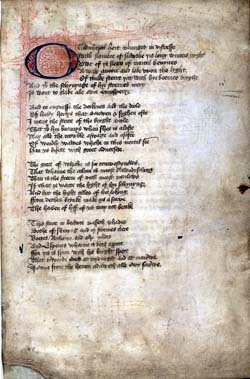
Opening page (folio 1r) |
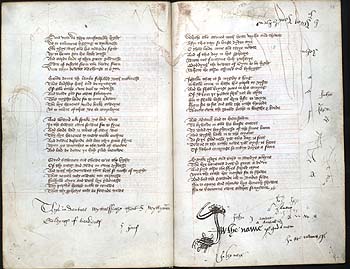
Opening with annotations (folios 57v - 58r) |
|
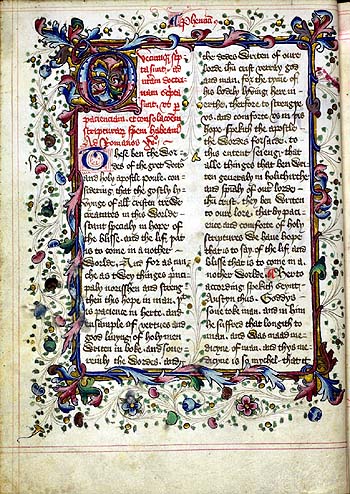
Illuminated page from the prologue (folio 3v) |
Nicholas Love Mirror of the Blessed Life of Jesus Christ
England: 1475
MS Hunter 77 (T.3.15)The Meditationes Vitae Christi, a devotional life of Christ originally
written in Latin, was extremely popular throughout medieval Europe. The Mirror
is a free translation of the work. It was made by Nicholas Love (d. 1424), a
prior of the Carthusian Priory of Mount Grace in Yorkshire. Concentrating on the
Passion, the Mirror dispenses meditative and doctrinal comment on the Bible. Its
sixty three chapters are each split into seven sections, every section
representing a day of the week.
This is a finely produced manuscript written in an expert script on good
quality vellum. It boasts several floreated pages, with illuminated initials and
decorative penwork throughout. Stephen Dodesham (d. 1481/82), its scribe, is
identified from a contemporary inscription on a flyleaf. He was a monk of Witham
Charterhouse near Frome, Somerset; he later moved to Sheen Charterhouse in
Richmond, Surrey, founded by Henry V in 1414. Dodesham was a prolific scribe
whose career began in the late 1420s; over twenty of his manuscripts survive,
including two others in the Hunterian collection.
|
|
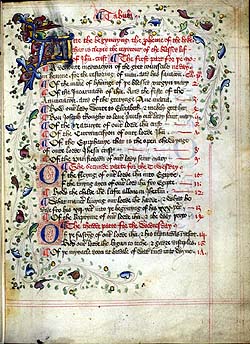
Table of contents (folio
1r) |
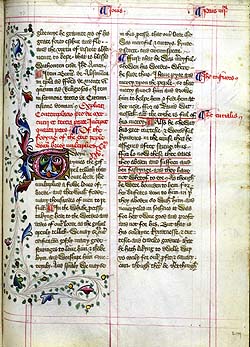
Decorated page ending book 3 and beginning book 4 (folio 76r) |
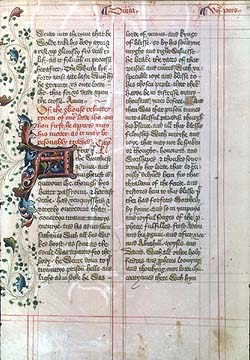
Decorated page ending part 6 and beginning part 7 (folio 133r) |
|
|